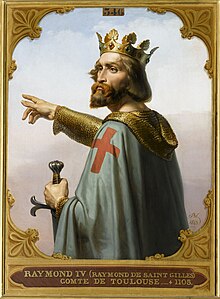Raymond IV, Count of Toulouse
| Raymond IV | |
|---|---|
Roman Catholic |
Raymond of Saint-Gilles (c. 1041 – 28 February 1105), also called Raymond IV of Toulouse or Raymond I of Tripoli, was the
Early years

Raymond was a son of
The First Crusade

Raymond was deeply religious, and wished to die in the Holy Land, and so when the call was raised for the
He was present at the
The "miracle" raised the morale of the crusaders, and to their surprise they were able to rout Kerbogha outside Antioch. The Lance itself became a valuable relic among Raymond's followers, despite Adhemar of Le Puy's skepticism and Bohemond's disbelief and occasional mockery. Raymond also refused to relinquish his control of the city to Bohemond, reminding Bohemond that he was obligated to return Antioch to the court of Emperor Alexios, as he had sworn to do. A struggle then arose between Raymond's supporters and the supporters of Bohemond, partly over the genuineness of the Lance, but mostly over the possession of Antioch.
Extending his territorial reach
Many of the minor knights and foot soldiers preferred to continue their march to Jerusalem, and they convinced Raymond to lead them there in the autumn of 1098. Raymond led them out to besiege Maarat al-Numan, although he left a small detachment of his troops in Antioch, where Bohemond also remained. As Adhemar had died in Antioch, Raymond, along with the prestige given to him by the Holy Lance, became the new leader of the crusade. Bohemond however, expelled Raymond's detachment from Antioch in January 1099. Raymond then began to search for a city of his own. He marched from Maarat, which had been captured in December 1098, into the emirate of Tripoli, and began the siege of Arqa on 14 February 1099, apparently with the intent of founding an independent territory in Tripoli that could limit the power of Bohemond to expand the Principality of Antioch to the south.
The siege of Arqa, a town outside Tripoli, lasted longer than Raymond had hoped. Although he successfully captured Hisn al-Akrad, a fortress that would later become the important Krak des Chevaliers, his insistence on taking Tripoli delayed the march to Jerusalem, and he lost much of the support he had gained after Antioch. Raymond finally agreed to continue the march to Jerusalem on 13 May, and after months of siege the city was captured on 15 July. Raymond was offered the crown of the new Kingdom of Jerusalem, but refused, as he was reluctant to rule in the city in which Jesus had suffered. He said that he shuddered to think of being called "King of Jerusalem". It is also likely that he wished to continue the siege of Tripoli rather than remain in Jerusalem. However, he was also reluctant to give up the Tower of David in Jerusalem, which he had taken after the fall of the city, and it was only with difficulty that Godfrey of Bouillon was able to take it from him.
Raymond participated in the
Crusade of 1101, siege of Tripoli, and death
Raymond was part of the doomed
The qadi of Tripoli, Fakhr al-Mulk ibn Ammar, led an attack on Mons Peregrinus in September 1104 and lit a wing of the citadel on fire. Raymond himself managed to escape across a rooftop, but was badly burned and spent his final months in agony.[5] Raymond died of his injuries on February 28, 1105, before Tripoli was captured.
Spouses and progeny
Raymond IV of Toulouse was married three times, and twice excommunicated for marrying within forbidden degrees of consanguinity by Pope Gregory VII in 1076 and in 1078. These excommunications were lifted in 1080, on the death of his first wife.[6]
His first wife was the daughter of
His second wife was Matilda (Mafalda), the daughter of Count Roger I of Sicily.[8] Married in 1080, Mafalda died in 1094.
Raymond's third wife was
Following Raymond's death, his nephew
Raymond of Toulouse seems to have been driven both by religious and material motives. On the one hand he accepted the discovery of the Holy Lance and rejected the kingship of Jerusalem, but on the other hand he could not resist the temptation of a new territory. Raymond of Aguilers, a clerk in Raymond's army, wrote an account of the crusade from Raymond's point of view.
References
- ^ Barker, Ernest (1911). . In Chisholm, Hugh (ed.). Encyclopædia Britannica. Vol. 22 (11th ed.). Cambridge University Press. pp. 934–935.
- ^ Bréhier, Louis (1911). "Raymond IV, of Saint-Gilles". In Herbermann, Charles (ed.). Catholic Encyclopedia. 12. New York: Robert Appleton Company.
- ^ a b Duncalf 1969, p. 272.
- ^ a b c Edgington & Sweetenham 2011, p. 391.
- ^ Maalouf 1983, p. 75.
- ^ Jean-Luc Déjean, The Counts of Toulouse (1050-1250), Fayard, 1979 (reprinted 1988) (ISBN 2-213-02188-0), p. 31-32.
- ^ William of Puylaurens 2003, p. 17.
- ^ Jansen, Drell & Andrews 2009, p. 428.
- ^ Oviedo 2000, p. 88 note91.
- ^ Graham-Leigh 2005, table 5.
Sources
- Duncalf, Frederic (1969). "The First Crusade: Clermont to Constantinople]". In Baldwin, Marshall W. (ed.). The History of the Crusades, Volume I: The First Hundred Years. University of Wisconsin Press. pp. 253–79.
- Edgington, Susan; Sweetenham, Carol, eds. (2011). The Chanson D'Antioche: An Old French Account of the First Crusade. Routledge.
- Graham-Leigh, Elaine (2005). The Southern French Nobility and the Albigensian Crusade. The Boydell Press.
- Jansen, Katherine L.; Drell, Joanna; Andrews, Frances, eds. (2009). Medieval Italy: Texts in Translation. Translated by Loud, G.A. University of Pennsylvania Press.
- Maalouf, Amin (1983). The Crusades Through Arab Eyes. JC Lattes. ISBN 0-8052-0898-4.
- Oviedo, Bishop Pelayo (2000). "Chapter II:Chronicon Regum Legionensium". The World of El Cid: Chronicles of the Spanish Reconquest. Translated by Barton, Simon; Fletcher, Richard. Manchester University Press.
- William of Puylaurens (2003). The Chronicle of William of Puylaurens: The Albigensian Crusade and its Aftermath. Translated by Sibley, W.A.; Sibley, M.D. The Boydell Press.

